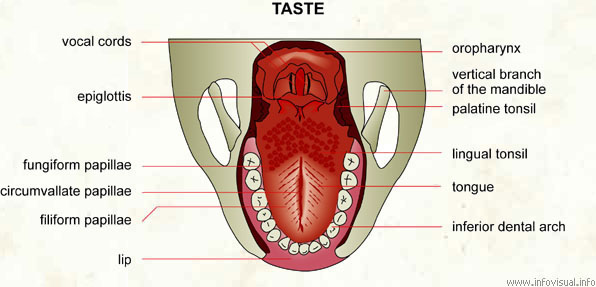Taste

Oropharynx: part of the pharynx in the area of the mouth.
Vertical branch of the mandible: division of the lower jaw aligned vertically with the body.
Palatine tonsil: type of tonsil (2) situated on one side or other of the isthmus of fauces.
Lingual tonsil: type of tonsil situated at the base of the tongue.
Tongue: organ of taste.
Inferior dental arch: set of teeth of the lower jaw.
Lip: external part of the mouth covering the teeth.
Filiform papillae: papillae that are not made up of taste-buds.
Circumvallate papillae: 6 to 12 papillae near the base of the tongue.
Fungiform papillae: mushroom-shaped papillae, about 200 in number, situated chiefly at the sides and centre on the tongue.
Epiglottis: a fold of cartilage that closes the glottis during swallowing.
Vocal cords: upper organs of speech.
Photo :
EN : Tongue
FR : Langue
ES : Lengüeta

The tongue is the large bundle of skeletal muscles on the floor of the mouth that manipulates food for chewing and swallowing. It is the primary organ of taste. Much of the surface of the tongue is covered in taste buds. The tongue with its wide variety of possible movements assists in forming the sounds of speech. It is sensitive and kept moist by saliva, richly supplied with nerves and blood vessels to help it move.